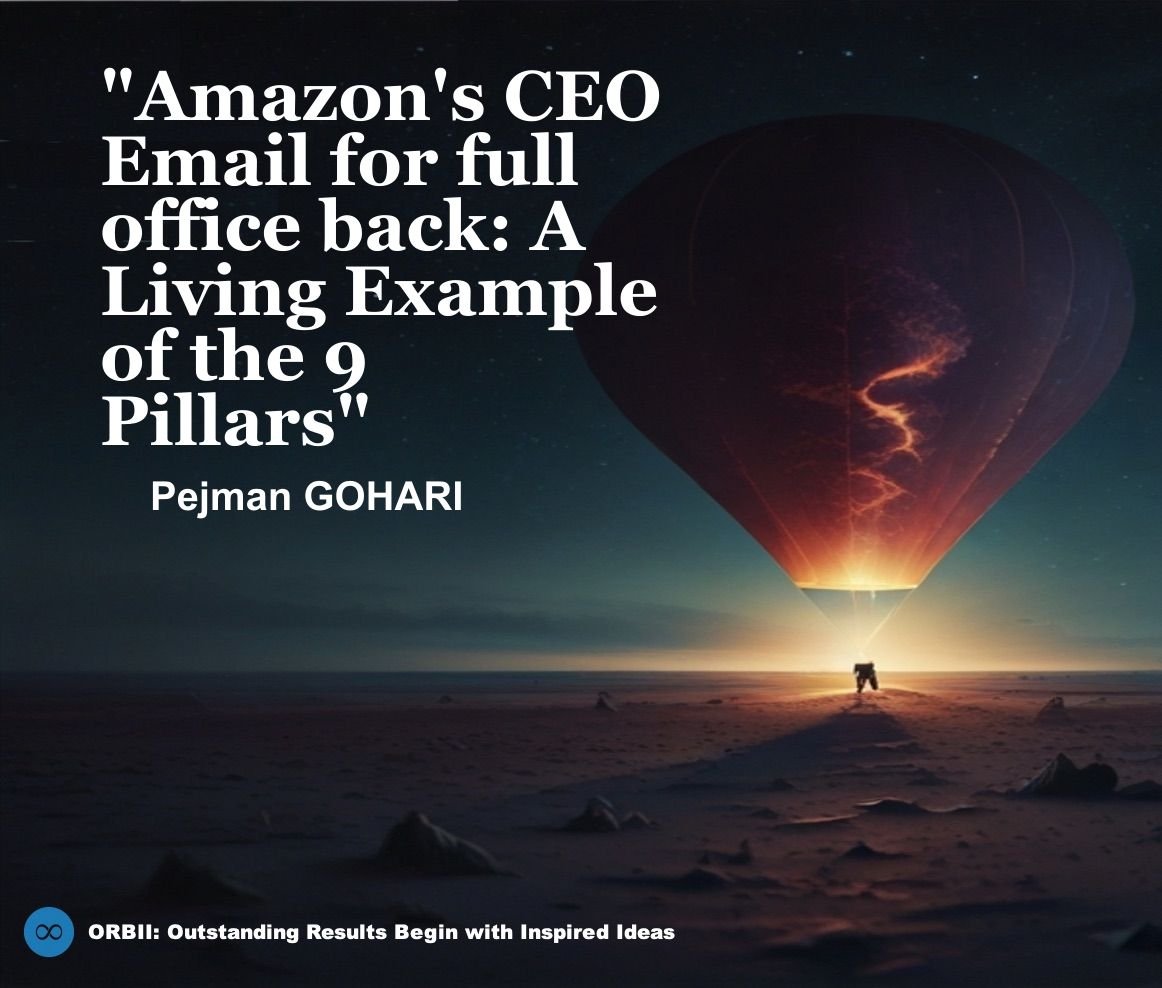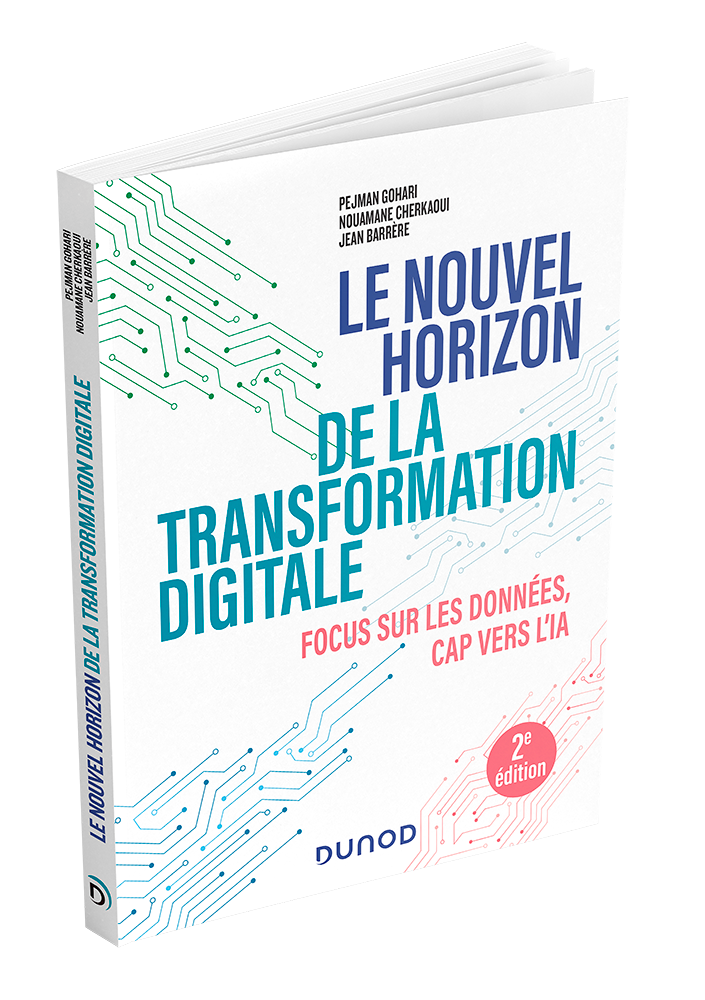Amazon's CEO Email for full office back: A Living Example of the 9 Pillars
When we wrote our book, we analyzed companies like Amazon in detail. But we didn't expect that just a week after its release, the CEO of Amazon would so vividly demonstrate our 9-pillar method. Whether one loves or dislikes Amazon isn't the point here. What's crucial is understanding how decisions are made and how Andy Jassy's email reflects a thought process aligned with their culture, strategy, and more. How does he propose to his collaborators to return to a full week at the office? Let's analyze.
In the rapidly evolving landscape of digital transformation, companies must navigate complex challenges to remain competitive. In our book, "The New Horizon of Digital Transformation - 2nd ed.: Focus on Data, Heading Towards AI", we identified nine essential pillars that organizations must embrace to thrive in the age of artificial intelligence (AI). Just a week after our book's release, Andy Jassy, CEO of Amazon, sent an email to his employees that exemplifies these pillars in action.
Let's delve into how Jassy's message reflects a strategic alignment with these pillars, focusing on the most prominent ones: strategy, customer obsession, culture, decision-making, talent, and velocity.
Strategy: Vision for Disruptive Innovation
"When I think about my time at Amazon, I never imagined I’d be at the company for 27 years... Part of why I’ve stayed has been the unprecedented growth... the perpetual hunger to invent, the obsession with making customers’ lives easier and better every day..."
— Andy Jassy
Andy Jassy begins his email by expressing confidence in Amazon's progress across various sectors, including AWS, Advertising, Prime Video, and new investment areas like generative AI, Project Kuiper, and Healthcare. This highlights Amazon's strategic approach to anticipate trends, shape innovation, and redefine industry norms—key aspects of a disruptive innovation strategy.
By investing in cutting-edge technologies and expanding into new markets, Amazon demonstrates a commitment to staying ahead of the curve. Jassy's emphasis on operating like "the world’s largest startup" underscores a strategy that prioritizes agility, continuous innovation, and a willingness to challenge the status quo.
Customer Obsession: The Core of Every Decision
"Our culture is unique, and has been one of the most critical parts of our success... Being so customer focused is an inspiring part of it..."
— Andy Jassy
Customer obsession is a foundational pillar for Amazon, deeply embedded in its culture and strategy. Jassy reiterates this by highlighting how every organizational change aims to "make customers’ lives easier and better every day." By bringing decision-making closer to the front lines, Amazon empowers employees who interact directly with customers to respond swiftly to their needs.
This approach ensures that customer satisfaction isn't just a corporate slogan but a practical guide for daily operations. It reflects a profound understanding that in the digital age, customer expectations evolve rapidly, and meeting them requires an organization to be nimble and deeply attuned to those it serves.
Culture: The DNA of Continuous Innovation
"Our culture is unique... You have to work at it all the time... Strengthening our culture remains a top priority..."
— Andy Jassy
Jassy places significant emphasis on culture as a critical component of Amazon's success. He acknowledges that maintaining a strong culture isn't automatic; it requires constant effort, especially in a rapidly growing organization. The mention of issues like unnecessary meetings and bureaucracy indicates an awareness of how growth can inadvertently introduce barriers to innovation and agility.
By addressing these challenges head-on, Jassy demonstrates a commitment to preserving the entrepreneurial spirit and core values that have driven Amazon's success. This aligns with the pillar of culture as the DNA of continuous innovation, where fostering an environment that encourages agility, creativity, and resilience is paramount.
Decision-Making: Speed and Proximity to the Customer
"We want more of our teammates feeling like they can move fast without unnecessary processes, meetings, mechanisms, and layers that create overhead and waste valuable time."
— Andy Jassy
Effective decision-making is critical in the fast-paced digital landscape. Jassy identifies that increased managerial layers have led to inefficiencies and a dilution of ownership among employees. By proposing to increase the ratio of individual contributors to managers by at least 15%, Amazon aims to flatten its organizational structure.
This move is designed to accelerate decision-making, reduce bureaucracy, and empower employees at all levels to take initiative. It embodies the pillar of making decisions informed by data and AI, where speed and informed judgment are essential to capitalize on opportunities and respond to challenges swiftly.
Talent: Empowering the Architects of Transformation
"We’ve always sought to hire very smart, high judgment, inventive, delivery-focused, and missionary teammates... We will do this thoughtfully..."
— Andy Jassy
Recognizing that talent is the backbone of transformation, Jassy emphasizes the importance of having the right people in the right roles. By reducing unnecessary managerial positions and fostering a sense of ownership among individual contributors, Amazon seeks to create an environment where talent can thrive.
This approach aligns with the pillar that views talents as architects of transformation. It acknowledges that empowering employees with autonomy and responsibility not only enhances job satisfaction but also drives innovation and performance.
Velocity: Agility in Execution at Scale
"We want to operate like the world’s largest startup... strong urgency... fast decision-making... decrease bureaucracy..."
— Andy Jassy
Velocity is crucial for any organization aiming to innovate rapidly and adapt to market changes. Jassy's vision of Amazon operating like "the world’s largest startup" encapsulates the essence of this pillar. By reducing layers of management and streamlining processes, Amazon aims to increase its agility and responsiveness.
This focus on speed doesn't come at the expense of thoughtful decision-making. Instead, it's about eliminating unnecessary obstacles that hinder progress. In a competitive landscape where timing can be a decisive factor, Amazon's emphasis on velocity ensures it remains ahead of the curve.
Returning to the Office: A Strategic Move Aligned with the Pillars
One of the most significant points in Jassy's email is the decision to return to office-based work. While this may seem counterintuitive in an era where remote work has become prevalent, Jassy provides compelling reasons that align with several of the pillars.
Enhancing Collaboration and Innovation
"When we look back over the last five years, we continue to believe that the advantages of being together in the office are significant... collaborating, brainstorming, and inventing are simpler and more effective..."
— Andy Jassy
Jassy argues that physical proximity enhances the ability to collaborate effectively, which is vital for innovation. Face-to-face interactions often lead to spontaneous idea generation and more robust problem-solving, supporting the culture of continuous innovation.
Strengthening Culture and Team Connections
"It’s easier for our teammates to learn, model, practice, and strengthen our culture... teams tend to be better connected to one another."
— Andy Jassy
By bringing employees back to the office, Amazon aims to reinforce its unique culture. Physical presence facilitates mentorship, the transmission of organizational values, and a stronger sense of community—all essential for maintaining a cohesive culture.
Facilitating Talent Development
"Teaching and learning from one another are more seamless..."
— Andy Jassy
The office environment provides opportunities for informal learning and professional development. It enables employees to observe and engage with peers and leaders directly, fostering talent growth and collaboration.
Conclusion: A Real-World Application of the 9 Pillars
Andy Jassy's email serves as a real-world demonstration of how an organization can embody the nine pillars of digital transformation. By strategically aligning decisions with core values and operational goals, Amazon showcases a holistic approach to navigating the complexities of the digital age.
- Strategy: Investing in disruptive technologies and new markets.
- Customer Obsession: Keeping customer needs at the forefront of all decisions.
- Culture: Actively cultivating a unique, innovation-driven culture.
- Decision-Making: Empowering employees and streamlining processes for faster execution.
- Talent: Valuing and developing individuals who drive transformation.
- Velocity: Maintaining agility and a startup mentality despite large-scale operations.
Whether one agrees with Amazon's policies or not, there's much to learn from how the company integrates these pillars into its strategic framework. For organizations seeking to thrive amidst rapid technological change, adopting similar principles can provide a roadmap for success.
Andy Jassy's message is not just an internal memo but a case study in effective leadership and strategic alignment. It highlights the importance of cohesive culture, strategic foresight, and operational agility—key elements that any organization can adopt to navigate the challenges of digital transformation successfully.
Licence: This article is published under the MIT Licence.



